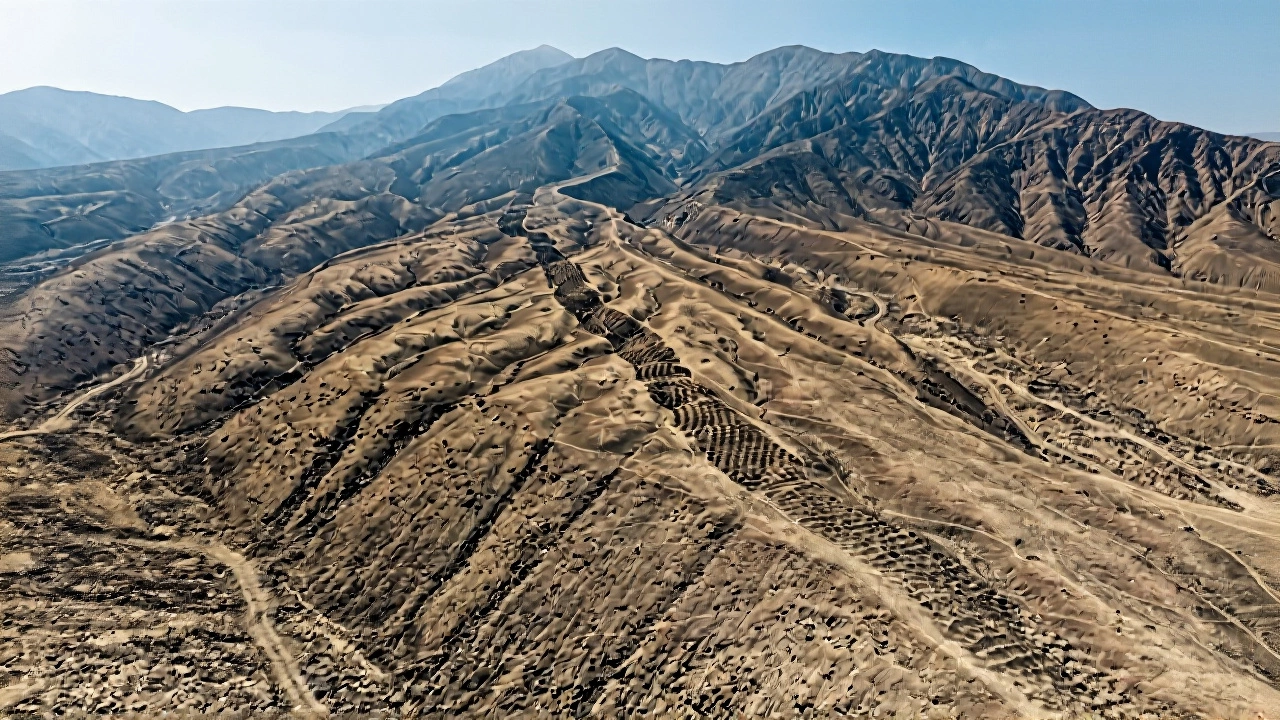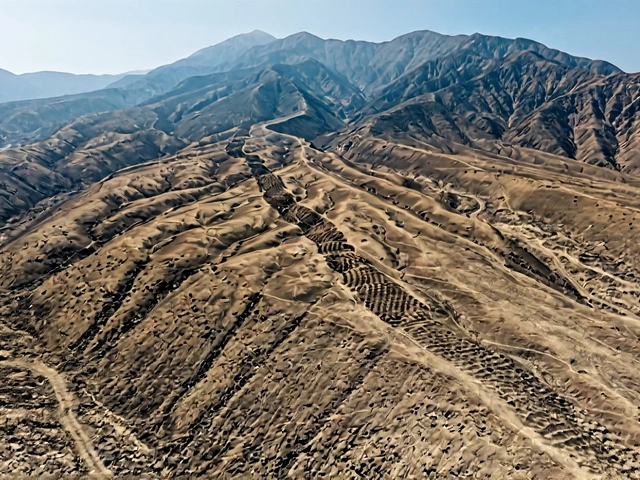Deep in the arid slopes of southern Peru’s Pisco Valley, 5,200 perfectly spaced holes carved into the mountainside have puzzled archaeologists for decades. Now, new evidence reveals they weren’t ceremonial, astronomical, or even agricultural — they were Peru’s ancient marketplace. A groundbreaking study published in Antiquity on November 10, 2025, concludes that the site known as Monte Sierpe — locally called the ‘Band of Holes’ — began as a bustling barter hub for the Chincha Kingdom, then evolved into a sophisticated Inca accounting system. The discovery, led by archaeologist Jacob Bongers, reshapes our understanding of pre-Columbian commerce and challenges long-held assumptions about Andean economic complexity.
The Site That Defied Explanation
Stretching 1.5 kilometers across the ‘Mountain of the Serpent,’ the Band of Holes consists of cylindrical depressions, each roughly 30 to 50 centimeters wide and up to a meter deep. Some are lined with stones; others are bare. They’re grouped into at least 60 distinct clusters, with blocks of about ten holes forming repeating patterns — eerily similar to the knot-based record-keeping system known as khipu, used by the Inca to track taxes, census data, and粮食物资. For over 50 years, researchers like Wallace (1971), Hyslop (1984), and Stanish & Tantaleán (2015) documented the site but could only guess. Water collection? Storage? Ritual? None fit.
Then came the drones.
Drone Eyes and Pollen Clues
Using high-resolution aerial imaging, Bongers’ team mapped every hole with centimeter precision. But the real breakthrough came from microbotanical analysis of 21 sediment samples taken from inside the holes. Pollen from maize, quinoa, and chili peppers — crops not native to the arid ridge — was found packed into the soil. One sample, from hole 1905-01, yielded charcoal dated to AD 1320–1405 via radiocarbon testing (UCIAMS 223236). That’s before the Inca fully absorbed the Chincha in the late 15th century.
“Local groups covered the holes with plant foods and introduced goods inside,” Bongers told NBC Palm Springs on November 22, 2025. “This wasn’t storage. It was display. It was trade.”
The pattern was unmistakable. Groups of ten holes matched the structure of khipu cords, where knots and spacing conveyed numerical values. In the Inca system, a single knot cluster could represent 100 units of maize. Here, clusters of ten holes may have marked quantities of traded goods — a physical ledger carved into stone.
From Market to Ledger: The Evolution
The Chincha Kingdom, with an estimated population of 100,000, dominated Peru’s central coast from AD 800 to 1475. They were master traders, exchanging fish, cotton, and ceramics for highland goods like potatoes and wool. The Band of Holes sat at the crossroads of their trade routes — high enough to be defensible, low enough to be accessible.
When the Inca conquered the Chincha around 1470, they didn’t destroy the site. They repurposed it. The Inca had no written language, but they had khipu. The holes, already organized into quantifiable units, became a physical extension of that system — a kind of proto-database where goods were counted, stored, and accounted for under imperial oversight.
“It’s not just a market,” says Dr. Elena Mendoza, an Andean economic historian at the University of Lima. “It’s a transition point — where informal barter became state-controlled logistics. That’s huge.”
Why This Changes Everything
For too long, scholars assumed the Inca were the first to develop complex administrative systems in the Andes. But the Band of Holes shows the Chincha were already managing large-scale exchange. The Inca didn’t invent accounting — they inherited and refined it.
This also suggests other mysterious Andean features — like the Nazca lines or the stone mounds of Caral — may have had economic functions we’ve overlooked. “We’ve been looking for gods in the rocks,” says Bongers. “Maybe we should’ve been looking for receipts.”
The site’s proximity to a pre-Hispanic defensive settlement further confirms its strategic value. This wasn’t a remote ritual site. It was a commercial nerve center.

What’s Next?
Researchers are already scanning other Andean ridges for similar patterns. Preliminary drone surveys near Huancavelica and Ayacucho have turned up clusters of holes with similar spacing — though not yet as extensive. If confirmed, this could mean the Band of Holes wasn’t unique — it was standard operating procedure.
Next year, Bongers’ team plans to excavate one cluster in full, hoping to find traces of textiles, baskets, or even rope remnants that once covered the holes. “We’re not just studying holes,” he says. “We’re studying how people trusted each other enough to leave goods in the ground and walk away — and come back later to collect.”
Historical Context: The Rise and Fall of the Chincha
The Chincha Kingdom rose to prominence after the fall of the Wari Empire around 1000 AD. They didn’t build pyramids or temples — they built trade networks. Their coastal ports handled goods from the Amazon, the highlands, and even as far as Ecuador. Their wealth came from control of the sea, not conquest.
When the Inca under Pachacuti expanded southward in the 1470s, they didn’t crush the Chincha. They absorbed them — using their infrastructure, their traders, their knowledge. The Band of Holes may have been one of the first things the Inca took over — not to erase, but to upgrade.
By the time the Spanish arrived in 1532, the site was already abandoned. The Inca Empire collapsed within a decade. But the holes? They remained. Silent. Unbroken. Waiting for someone with the right tools — and the right questions — to listen.
Frequently Asked Questions
How did researchers confirm the holes were used for trade and not storage?
Microbotanical analysis detected pollen from crops like maize and chili peppers — plants that don’t grow naturally on the arid ridge — inside the holes. This means goods were deliberately placed there. Also, the holes show no signs of soil buildup or erosion that would suggest long-term storage. Instead, their arrangement into repeating clusters mirrors the khipu accounting system, indicating they were used to count and display traded items.
Why is this discovery significant for understanding Inca administration?
It proves the Inca didn’t invent their accounting system from scratch. They adopted and refined an existing indigenous framework developed by the Chincha. The Band of Holes shows that complex economic record-keeping existed in the Andes over 150 years before the Inca Empire peaked. This forces historians to rethink the timeline of state-level administration in pre-Columbian South America.
Could similar sites exist elsewhere in the Andes?
Yes. Early drone surveys near Huancavelica and Ayacucho have already identified smaller clusters of holes with similar spacing and organization. Researchers believe these may be regional variations of the same system. If confirmed, this could mean the Band of Holes was part of a widespread network — not an isolated oddity — suggesting a continent-wide culture of indigenous economic tracking.
What role did the Chincha Kingdom play in Andean history?
The Chincha were the most powerful pre-Inca traders in the central Andes, controlling coastal ports and inland routes with a population of around 100,000. Unlike militaristic empires, they built wealth through commerce — exchanging fish, cotton, and salt for highland crops and wool. Their collapse under Inca rule wasn’t violent; it was bureaucratic. The Band of Holes reveals how their economic innovations were absorbed, not erased, by the Inca.
How does this change our view of indigenous innovation?
It shatters the myth that indigenous societies lacked complex systems without writing. The Band of Holes is a physical, tactile database — a 5,200-point ledger carved into stone. It shows that accounting, quantification, and record-keeping weren’t European imports. They were Andean inventions, refined over centuries. This rewrites the narrative of who built civilization in the Americas — and how.
Why wasn’t this site discovered earlier?
The holes blend into the rocky terrain, and early archaeologists focused on temples and tombs, not economic infrastructure. Without drones and microbotanical tools, the patterns were invisible. Even Hyslop, who mapped the site in 1984, called it ‘enigmatic.’ It took modern technology — and a willingness to ask new questions — to see what was always there.







